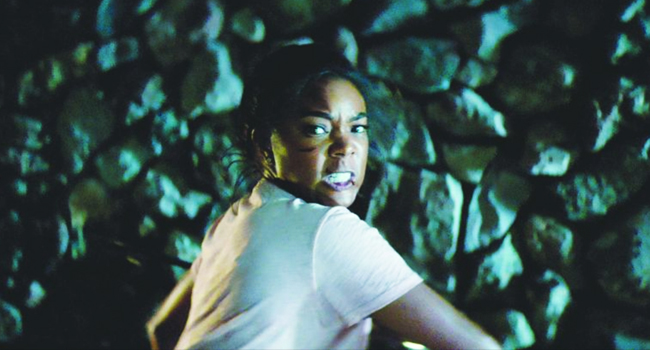
This weekend, Universal drops the latest contribution to the home invasion horror (and thriller) subgenre with Breaking In, in which Gabrielle Union’s character defends her progeny while letting her intruders know that they chose the wrong damn house to invade. Given that the film arrives on Mother’s Day weekend (and has been promoted as a Mother’s Day movie), it should be safe to assume the bad guys get what they deserve, even if the film apparently uses the “mom” label to simply pat women on the head for doing it all while being able to whoop bad-guy ass. A more nuanced treatment would have been delicious in a year where women have been taking back the power in so many other ways.
A home invasion film would actually be a great vehicle to serve such an ultimate purpose, since the subgenre has been used as cultural commentary for several decades — beginning with D.W. Griffith’s The Lonely Villa in 1909. Since folks apparently can’t get enough of the stranger-in-one’s-home archetype, the decades following have seen endless permutations in multiple mainstream films arriving each year. The concept somehow remains so ripe with potential that, at times, it’s a joy in and of itself to see what type of spin will arrive with the next member of the subgenre.
Yet despite the imaginative nature of suspense writers, it seems that their treatment of women in home invasion films rarely changes. Yes, other forms of cultural commentary persist with the attempting of righted wrongs. Just to name a few well-treaded examples, recent years have brought impressive twists that have been particularly unsettling with the panic-inducing Don’t Breathe setting up audiences to root for the invaders in a crudely effective refashioning of the formula. That film, along with The Purge, drips with thematic currents that skewer Americans’ racism and outright xenophobia.
In Don’t Breathe, a blind veteran must fend off his intruders, but he’s certainly not a hero — and that’s where the film gets dicey with its treatment of women. The vet had already impregnated one captive, and after accidentally shooting her, he tried to rape Jane Levy’s Rocky (while claiming, “I’m not a rapist”) with a turkey baster in a scene so controversial and notorious that, years later, one really wonders what director Fede Alvarez aimed to do. He succeeded at turning several horror tropes on their heads, but still, the female lead (who is rescued by a guy who wants to bang her) remains the target of gendered violence, all because she’s a woman and, therefore, capable of being a mom.
These films’ presumed grounding in reality (even though examples like Rosemary’s Baby include supernatural elements) make them all the more horrifying, and their take on gender is, unfortunately, often very realistic. And the invaders, as fellow humans, resemble ourselves with rationales that wildly vary. While some intruders carefully choose their victims as a means of revenge or in pursuit of something in particular, the selection process can be random (or, at least, it initially appears that way), which only adds to the helplessness felt by audiences. And rarely are victims as well-equipped as Macaulay Culkin in Home Alone (obviously a rare comedic variant on the archetype) — it happens, but seldom is the premise set up well.
For example, the familiar “Final Girl” trope still comes back to play in horror films. Occasionally, as in You’re Next, she’s got survivalist skills (as honed in the Australian outback). That home invasion flick is arguably the strongest example of a feminist effort from screenwriters, but even so, we don’t learn whether the Final Girl lives or dies, or if she’s forever damaged after her experiences. Elsewhere, the Final Girl in home-invasion films has to be really fortunate not to endure torture or be raped — before she kills the killer or simply lives to tell the story, rather than being tossed into a watery grave as with Funny Games.
And as is often the case, the home invasion occurs after a perceived wrong by a female character. Everyone is aware of how the horror genre judges promiscuity. A couple that has premarital sex is usually as good as dead, but the “wrong” can take a different turn. Case in point — 2008’s The Strangers remains one of the most horrifying invasion movies of the past decade, and one of the film’s messages was decidedly unfeminist. That is to say, Liv Tyler’s character refuses a marriage proposal, and soon enough, she’s being figuratively punished while fighting off masked murderers.
What is clear is this — home invasion is the ideal concept for filmmakers to easily conjure up tension and feed an audience’s sense of claustrophobia. Lighting, pace, sound, can all be effectively deployed to nurture the atmosphere, and there are few things more terrifying than realizing that your home — the place of refuge from the world — will never be the same. With all of the creative ways that screenwriters have employed to tell these stories, they could also stand to modernize their female characters rather than rely on the same old tropes.
Yet the tactic continues. Darren Aronofsky aimed for the allegorical stars with his home invasion twist in 2017’s mother!, in which a god-like husband (who was essentially gaslighting his wife) invited strangers into their home before horrors unfolded. This, of course, harkens back to the 1944 classic film, Gaslight, in which the victim’s husband, who should be familiar to her, is actually a stranger with nefarious purposes. Though he’s not technically a home invader, the effect is largely the same. Perhaps one day, the endless stream of home invasion films — stretching from When A Stranger Calls to Straw Dogs and beyond — will tweak the one thing that never seems to change. That is, this subgenre’s largely patronizing treatment of women.






